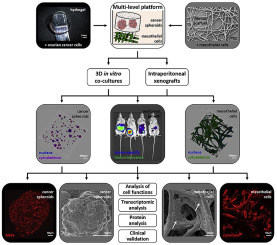Biomaterials ( IF 12.8 ) Pub Date : 2018-10-16 , DOI: 10.1016/j.biomaterials.2018.10.014 Daniela Loessner , Anja Rockstroh , Ali Shokoohmand , Boris M. Holzapfel , Ferdinand Wagner , Jeremy Baldwin , Melanie Boxberg , Barbara Schmalfeldt , Ernst Lengyel , Judith A. Clements , Dietmar W. Hutmacher

|
Peritoneal invasion through the mesothelial cell layer is a hallmark of ovarian cancer metastases. Using tissue engineering technologies, we recreated an ovarian tumor microenvironment replicating this aspect of disease progression. Ovarian cancer cell-laden hydrogels were combined with mesothelial cell-layered melt electrospun written scaffolds and characterized with proliferation and transcriptomic analyses and used as intraperitoneal xenografts. Here we show increased cancer cell proliferation in these 3D co-cultures, which we validated using patient-derived cells and linked to peritoneal tumor growth in vivo. Transcriptome-wide expression analysis identified IGFBP7, PTGS2, VEGFC and FGF2 as bidirectional factors deregulated in 3D co-cultures compared to 3D mono-cultures, which we confirmed by immunohistochemistry of xenograft and patient-derived tumor tissues and correlated with overall and progression-free survival. These factors were further increased upon expression of kallikrein-related proteases. This clinically predictive model allows us to mimic the complexity and processes of the metastatic disease that may lead to therapies that protect from peritoneal invasion or delay the development of metastasis.
中文翻译:

3D肿瘤微环境调节细胞增殖,腹膜生长和表达模式
通过间皮细胞层的腹膜浸润是卵巢癌转移的标志。使用组织工程技术,我们重建了卵巢肿瘤微环境,复制了疾病进展的这一方面。将载有卵巢癌细胞的水凝胶与间皮细胞层的熔融电纺丝书面支架相结合,并通过增殖和转录组分析进行表征,并用作腹膜内异种移植物。在这里,我们显示了在这些3D共培养物中癌细胞增殖的增加,我们使用患者衍生的细胞对其进行了验证并与体内腹膜肿瘤的生长有关。全转录组表达分析确定,与3D单培养相比,IGFBP7,PTGS2,VEGFC和FGF2在3D共培养中是双向调控的双向因子,我们通过异种移植和患者来源的肿瘤组织的免疫组织化学证实了这一点,并与总体生存期和无进展生存期相关。当激肽释放酶相关的蛋白酶表达时,这些因素进一步增加。这种临床预测模型使我们能够模拟转移性疾病的复杂性和过程,从而可能导致保护免受腹膜浸润或延迟转移发展的疗法。











































 京公网安备 11010802027423号
京公网安备 11010802027423号